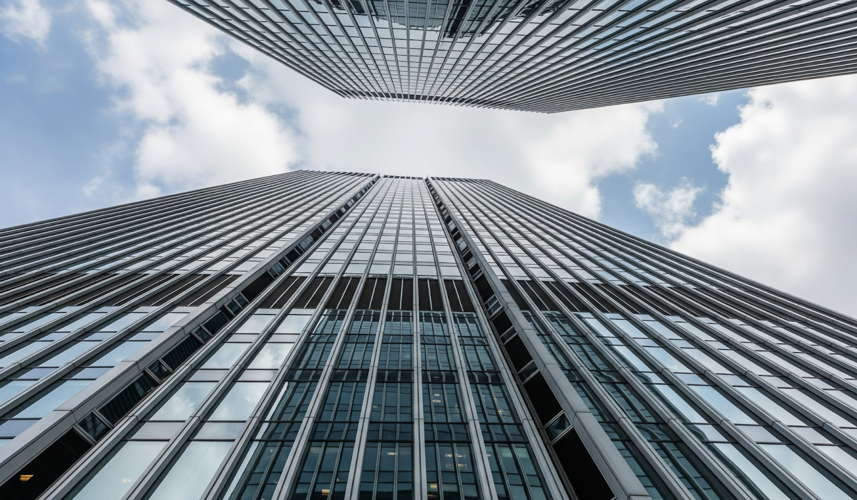Modern architects create grandiose structures. Photography often does not reflect their true size, turning giants into flat pictures. As a travel photographer, I, Lev Mazaraki, became convinced that in order to show the grandeur of a building, you need to control the viewer's perception. To do this, I use three proven techniques.

The lens controls perspective
The choice of lens determines how the viewer feels about the space. This is not just a technical detail, but a tool for creating the right emotion.
The wide-angle lens helps create drama. Shooting a skyscraper from a lower angle causes the vertical lines to converge rapidly. The prospect is exaggerated, and a person feels powerful, almost dizzy. Research by neuroscientists from MIT shows that the human brain processes a visual image in just 13 milliseconds — faster than it can read a word. Therefore, such a direct effect on perception works flawlessly.
The telephoto lens solves another problem: it "compresses" the space. Imagine a villa set against the backdrop of distant mountains. Shooting from a long distance visually "brings" the mountains closer to home. The viewer sees how huge the surrounding landscape is compared to the building, and realizes the true size of the object.
A person measures the space
Our brain has a poor understanding of abstract meters. But he instantly evaluates the scale when he sees a familiar object in the frame, such as a human figure. The presence of people turns an abstract picture into a living scene.
To show the size of a huge panoramic window, it is enough to place a silhouette of a person next to it. The brain will automatically compare the dimensions, and the scale of the structure will become obvious without any numbers. This technique works more accurately than any technical description.
The same principle applies in large rooms. A person walking through a spacious hall or atrium not only enlivens the frame. His figure emphasizes the volume and "air" around him. The viewer can almost physically feel the emptiness and vastness of the hall.

The drone reads the architect's idea
Shooting from the ground shows us the building as an object. Aerial photography reveals it as part of a larger system. In recent years, the number of drones registered in Russia for commercial photography has doubled. This opened up new opportunities for photographers.
The frame, taken vertically by the camera, turns the villa, garden and pool into a living architectural drawing. The viewer sees not just a house, but the geometry and logic of the entire space. The connection of the object with the surrounding landscape becomes clear.
A smooth flight around the villa on the cliff solves a different problem. This is the only way to show how boldly architecture fits into a complex terrain. An aerial camera demonstrates the building's interaction with the sea and coastline. This way we convey not only the size, but also the unique context.

Perception traps: 3 mistakes that "Kill" the Scale
Even when shooting grandiose objects, you can get flat and featureless results. This is usually due to three common mistakes.
Inappropriate distortion. A wide — angle lens is a powerful tool, but it is often used to simply "fit everything" into the frame. As a result, the edges of the image stretch, straight lines bend, and the majestic building turns into a caricature. The rigor of geometry disappears, and with it the feeling of power.
An "empty" scale. A huge lobby or facade without a single familiar object in the frame leaves the brain at a loss. The viewer does not have a reference point to assess the actual size. The space seems smaller and less impressive than in real life. Greatness is lost in the void.
A banal aerial view. The drone gives you freedom, but it often leads to the same kind of shots: a house somewhere in the center, shot from a great height. Such a picture shows the plan, but not the character. It does not convey either the height of the building or its relation to ground level. In order for the drone to work at scale, you need to look for unique angles, and not just climb as high as possible.
These three techniques prove that the transfer of scale depends on the conscious choice of the photographer. By controlling perspective, introducing a person into the frame and using angles from a height, architecture can be restored to its true grandeur. A good photo doesn't just document a building. She gives him a voice and allows the viewer to experience the same emotions as when meeting him live.
For me, working with architecture is always a dialogue. I'm not just fixing stone and glass. I'm trying to hear the story that the architect told and translate it into the language of light and composition. The best shots are born not when you find the perfect angle, but when you understand the idea.





(0) comments
We welcome your comments
Log In
Post a comment as Guest
Keep it Clean. Please avoid obscene, vulgar, lewd, racist or sexually-oriented language.
PLEASE TURN OFF YOUR CAPS LOCK.
Don't Threaten. Threats of harming another person will not be tolerated.
Be Truthful. Don't knowingly lie about anyone or anything.
Be Nice. No racism, sexism or any sort of -ism that is degrading to another person.
Be Proactive. Use the 'Report' link on each comment to let us know of abusive posts.
Share with Us. We'd love to hear eyewitness accounts, the history behind an article.